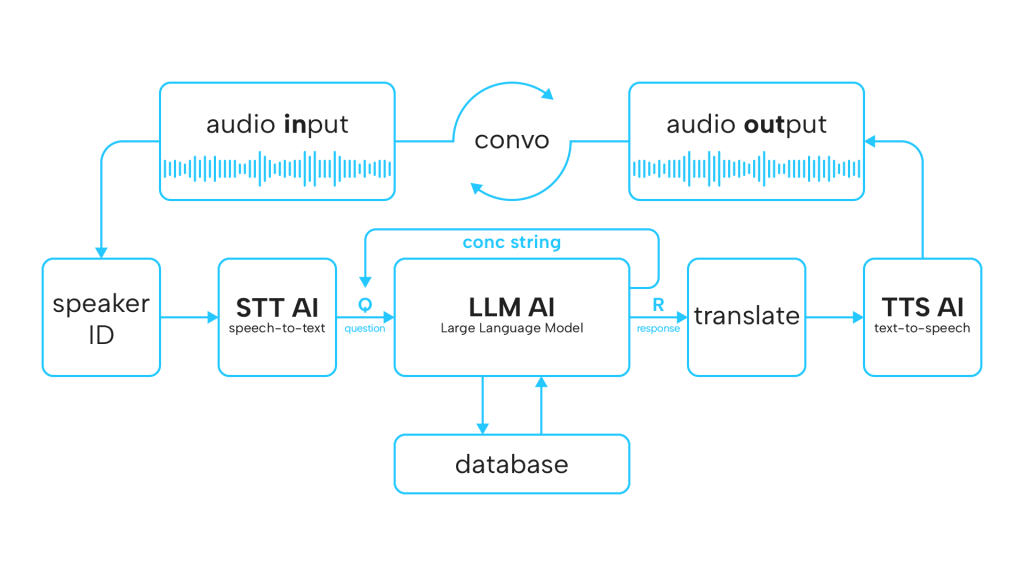Unveiling the Magic behind Conversational AI
Overview
- The Basics: Understanding Its Core
- Training Your Own: Resources
- The Business Case: Pro’s of convo AI for companies
- People Ask: Frequently Asked Questions
Basics of Conversational AI
Conversational AI represents the forefront of innovation in artificial intelligence, designed to simulate human-like conversations. At its heart lies Natural Language Processing (NLP), a pivotal component enabling machines to understand, interpret, and respond to human language.
This technology powers various applications, from Chatbots to virtual assistants, significantly enhancing User Experience.
One cannot overstate the importance of NLP in Conversational AI. It’s like a master linguist, adeptly navigating the complexities of human language, ensuring seamless and meaningful dialogues between humans and machines. Its role is indispensable in crafting natural and engaging conversations.

Audio Input: At the onset, spoken language is captured as audio input. This represents the initial user voice or command intended for the AI system to process.
Speaker ID: Before processing the audio, the system identifies who the speaker is. This can be useful in personalized AI applications, allowing for tailored interactions based on the identified user.
STT AI (Speech-to-Text): Once the speaker is identified and audio input is secured, it undergoes a transformation into text via Speech-to-Text algorithms. This module accurately converts spoken words into a textual “question” format.
Convo & Conc String: These denote the core mechanics of the conversation and the consolidation of the conversation strings. They ensure that the flow of interaction is maintained and that all elements of the conversation are kept in a unified context.
LLM AI (Large Language Model): Serving as the central processing unit, the LLM AI receives the transcribed question and taps into its extensive database to derive an apt “response.” It contextualizes the input and generates relevant outputs.
Database: The LLM AI interfaces with a comprehensive database. This repository is pivotal in storing vast amounts of data and information that the LLM AI uses to generate its responses.
Translate: Post response generation, there may be a need to render the output in a different language. The “translate” module comes into play here, offering multilingual support by adapting the response to a desired language.
TTS AI (Text-to-Speech): As the culminating step, the textual response is converted back into spoken language. This is achieved through Text-to-Speech algorithms, delivering the AI-generated answer in an audible format, thereby rounding off the conversational loop with the “audio output.”

Training your own Conversational AI
Dipping your toes into the vast ocean of Conversational AI might seem daunting, but with the right tools and guidance, you can train your very own model. Let’s break it down into actionable steps:
a. Start with Understanding NLP (Natural Language Processing):
Before diving into conversational AI, it’s crucial to grasp the basics of NLP. It’s the backbone of every conversational AI system, enabling machines to understand, interpret, and produce human language.
Resource: Stanford University’s NLP Course
b. Choose the Right Framework:
There are several AI frameworks and platforms tailored for conversation. Some of the popular ones include:
- Rasa: An open-source platform offering tools to customize and extend your conversational AI.
- Dialogflow: Google’s human-computer interaction development suite, harnessing Google’s Natural Language Processing.
c. Data Collection:
The quality of your AI model heavily relies on the data it’s trained on. Start by gathering conversation logs, chat histories, and any other relevant textual data. This will serve as the foundational training material.
Resource: Platforms like Chatito can help in generating training datasets for NLP tasks.
d. Model Training:
With your data in place, initiate the training process. This involves feeding your data into the model, allowing it to learn patterns, contexts, and semantics. Regularly test and fine-tune the model for optimized performance.
e. Integration:
Once trained, integrate your model into the desired application. This could range from chatbots on websites to virtual assistants on smartphones.
Resource: BotPress offers a platform to design, train, and integrate conversational AI into various applications.
f. Continuous Learning:
AI, especially in the conversational realm, isn’t a set-it-and-forget-it tool. Regularly gather new data, update the model, and refine its responses. Feedback loops from users can provide invaluable insights.
g. Explore Advanced Features:
Many platforms offer advanced functionalities like sentiment analysis, multi-language support, and voice integration. Explore these to enhance user experience further.
Resource: Wit.ai by Facebook is a great platform for voice and text-based applications.
Need help setting up conversational AI in your company?

The Business Case for Investing in Conversational AI
1. Enhanced Customer Experience
- 24/7 Availability:Conversational AI can operate around the clock, ensuring customers receive assistance anytime they need it.
- Instant Response: Unlike human operators who might be handling multiple queries, AI-powered chatbots can provide immediate responses, reducing wait times.
- Personalization: Advanced AI models can remember past interactions, offering personalized experiences and product recommendations based on user behavior and preferences.
2. Cost Savings
- Automation of Repetitive Tasks: A significant portion of customer queries are often repetitive. AI can handle such queries, freeing up human agents for more complex issues.
- Reduced Human Errors: Automated responses ensure accuracy and consistency in information dissemination.
3. Scalability
As businesses grow, the volume of customer interactions can increase exponentially. Conversational AI systems can effortlessly scale to handle thousands of interactions simultaneously, something that would be costly and challenging with a human-only approach.4. Rich Data Insights
- Behavior Analysis: Conversational AI platforms can analyze customer interactions, providing insights into user behavior, preferences, and pain points.
- Continuous Improvement: These insights can be used to refine marketing strategies, improve products/services, and enhance overall user experience.
5. Diverse Applications
From customer support and sales to HR and internal operations, the applications of conversational AI are vast. For instance, HR bots can help answer employee queries about policies or leave applications, while sales bots can guide users through product selections.6. Competitive Edge:
Early adoption of AI can give businesses a significant advantage over competitors. It showcases a commitment to innovation and can be a differentiating factor in market positioning.7. Integration Capabilities:
Modern conversational AI systems can integrate with a wide range of business applications – from CRM systems to inventory management software. This seamless integration ensures a cohesive flow of information and enhanced operational efficiency.8. Future-Proofing:
As technology continues to evolve, customer expectations shift along with it. Investing in AI now prepares businesses for the future, ensuring they remain relevant and can adapt to changing technological landscapes.People ask
How does conversational AI work?
Conversational AI functions through Machine Learning models trained on vast datasets, enabling it to understand and generate human-like responses.
How do you train your own conversational AI?
Training involves selecting appropriate models, feeding them diverse conversational data, and continuously refining based on feedback.
What are some conversational AI examples?
Examples include customer service chatbots, voice-activated virtual assistants, and AI-powered language tutors.
What is the difference between AI and conversational AI?
While AI is a broad field encompassing various technologies, Conversational AI specifically focuses on human-like conversational capabilities.
Keep reading
How to create Mortal Kombat with AI characters video
The process detailing on how to make a Mortal Kombat…
Read More




